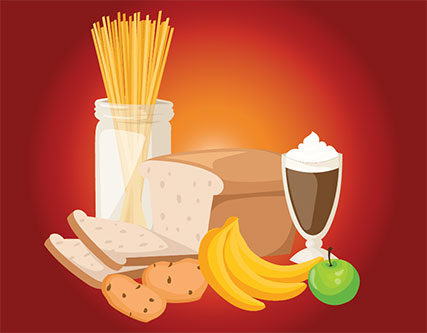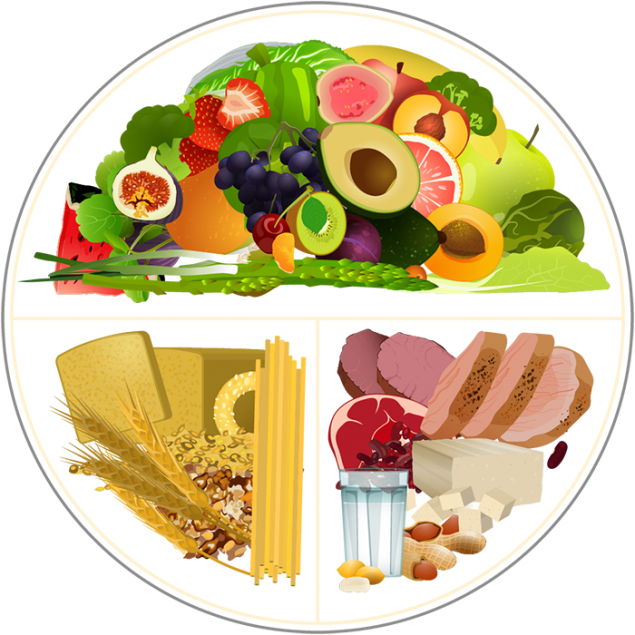Diabetes Meal Planning

Counting carbs and the plate method are two common tools that can also help you plan meals.
A meal plan is your guide for when, what, and how much to eat to get the nutrition you need while keeping your blood sugar levels in your target range. A good meal plan will take into account your goals, tastes, and lifestyle, as well as any medicines you’re taking.
You’ll want to plan for regular, balanced meals to avoid high or low blood sugar levels. Eating about the same amount of carbs at each meal can help.
Carbs, protein, fat, and fiber in food all affect your blood sugar in different ways. Carbs can raise your blood sugar faster and higher than protein or fat. Fiber can help you manage your blood sugar, so carbs that have fiber in them, like sweet potatoes, won’t raise your blood sugar as fast as carbs with little or no fiber, such as soda.
Counting Carbs

For more information, see Carb Counting.
Keeping track of how many carbs you eat and setting a limit for each meal can help keep your blood sugar levels in your target range. Work with your doctor or dietitian to find out how many carbs you can eat each day and at each meal, and then refer to this list of common foods that contain carbs and serving sizes. For more information, see Carb Counting.
Another way to manage the carbs you eat is using the glycemic indexexternal icon (GI). The GI ranks carbs in food from 0 to 100 according to how much they affect blood sugar. Low GI foods are more slowly digested and absorbed by your body, so you stay full longer. They don’t have a big impact on your blood sugar. High GI foods are digested and absorbed more quickly. They have a bigger impact on your blood sugar, and you’ll get hungry sooner. Some examples:
- High GI: Bread (white and wheat), mashed potatoes, watermelon, fruit juice
- Low GI: Beans, brown rice, tomatoes, yogurt, apples, milk
The Plate Method

It’s easy to eat more food than you need without realizing it. The plate method is a simple, visual way to make sure you get enough non-starchy vegetables and lean protein, and limit the amount of higher-carb food that has the greatest potential to spike your blood sugar.
Start with a 9-inch dinner plate:
- Fill half with non-starchy vegetables, such as salad, green beans, broccoli, cauliflower, cabbage, and carrots.
- Fill one quarter with a lean protein, such as chicken, turkey, beans, tofu, or eggs.
- Fill a quarter with a grain or starchy food, such as potatoes, rice, or pasta (or skip the starch altogether and double up on non-starchy veggies).
Did you know? Food portions are much larger now than they were 20 years ago. Test your knowledge of portion distortion hereexternal icon.
Portion Size
Portion size and serving size aren’t always the same. A portion is the amount of food you choose to eat at one time, while a serving is a specific amount of food, such as one slice of bread or 8 ounces (1 cup) of milk.
These days, portions at restaurants are quite a bit larger than they were several years ago. One entrée can equal 3 or 4 servings! Studies show that people tend to eat more when they’re served more food, so getting portions under control is really important for managing weight and blood sugar.
If you’re eating out, have half of your meal wrapped up to go so you can enjoy it at a later time. At home, measure out snacks; don’t eat straight from the bag or box. At dinnertime, dish out one serving of each dish per plate. Reduce the temptation to go back for seconds by keeping the serving bowls out of reach. And with this “handy” guide, you’ll always have a way to estimate portion size at your fingertips:
Get Help
Planning meals that fit your health needs, tastes, budget, and schedule can be complicated. Work with your doctor, diabetes educatorexternal icon, or dietitian to create a healthy meal plan just for you.
- More About Meal Planning
- Weekly Meal Planner pdf icon[PDF – 30 KB]
- ADA: Diabetes Food Hub – Recipes for Healthy Livingexternal icon
- Tasty Recipes for People with Diabetes and Their Families pdf icon[PDF – 9 MB]
- ChooseMyPlate – Plan Your Weekly Mealsexternal icon
- Rethink Your Drink
- Recipes for a Heart-Healthy Lifestyleexternal icon
